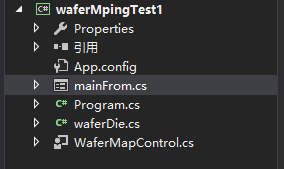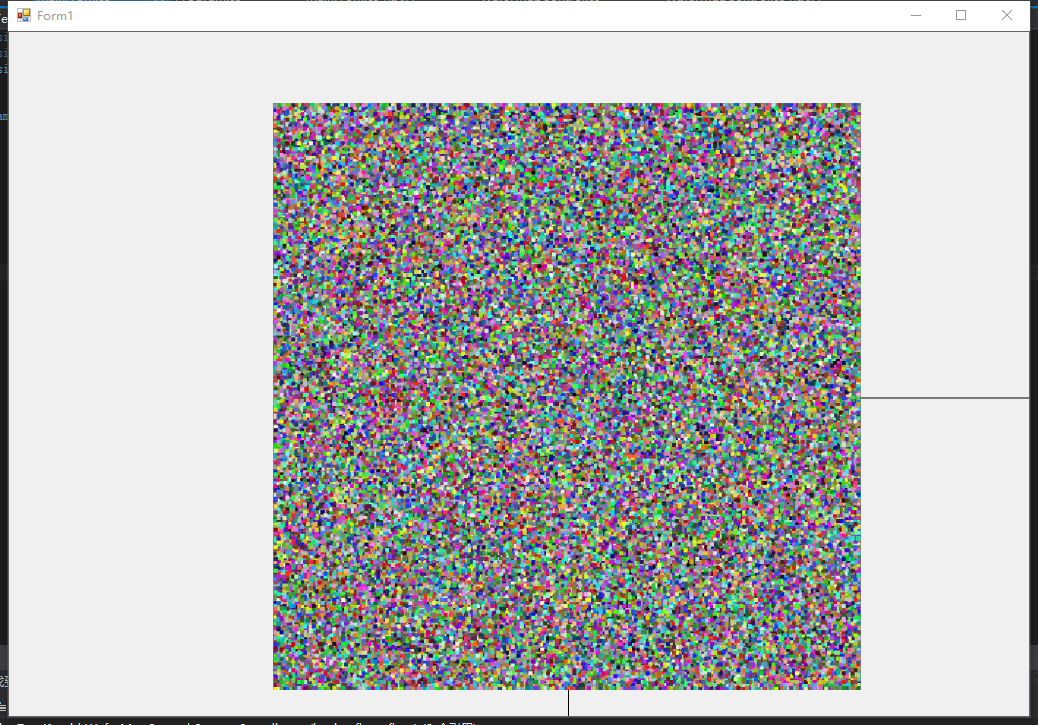原文作者:aircraft
原文地址:https://www.cnblogs.com/DOMLX/p/18729664
第一 简介
又是好久没更新了,今天介绍个半导体/led行业生成晶圆片map图的小demo程序。
在半导体和led中经常需要对下图中的一个个晶圆片上的一个个die(晶圆)生成一个总体的map图,不管是检测中用来显示晶圆片上各个Die的好坏分布,还是用作于点击晶圆移动查看都是有必要的。

像正常在半导体或者LED设备公司中工作过的人基本都有完整的map的显示控件的封装代码,但是如果你是刚跨行过来,或者是自己想研究学习,那么基本就要自己开发一个MAP控件。比如下图那样的就是
工业公司开发的MAP控件led软件上显示的效果。

第二 demo结构
工具环境是在VS2015下 c#6.0以下的语法环境 基于c#和winfrom的对话框程序

mainFrom.cs就是个显示作用的窗体
waferDie.cs里只定义了Die类里面存放每个Die的行列坐标和颜色信息以及一些其他信息比如检测好坏等
WaferMapControl.cs就是创建个用户控件类,在上面实现绘制MAP功能,外部只要把晶圆的队列数组传入就可以直接使用
非常简单的三个文件,只要自己创建一下名字相同的三个代码文件,然后复制我下面的代码进去就可以运行使用了。注意:WaferMapControl是个用户控件,可以点添加,选择用户控件,然后改一下名字。
第三 代码
mainFrom界面图:

中间添加了一个panel的控件,属性为填充
mainFrom.cs代码:
using System;
using System.Collections.Generic;
using System.ComponentModel;
using System.Data;
using System.Drawing;
using System.Linq;
using System.Text;
using System.Threading.Tasks;
using System.Windows.Forms;
namespace waferMpingTest1
{
public partial class mainFrom : Form
{
public mainFrom()
{
InitializeComponent();
InitializeWaferMap();
//GenerateTestData(1000000); // 生成测试数据
GenerateTestData2(10); // 生成测试数据
}
WaferMapControl waferMap = new WaferMapControl
{
Dock = DockStyle.Fill,
BorderStyle = BorderStyle.FixedSingle
};
private void InitializeWaferMap()
{
waferMap.DieClicked += (s, e) =>
MessageBox.Show($"Clicked Die: ({e.Die.Row}, {e.Die.Column})");
panel1.Controls.Add(waferMap);
//Controls.Add(waferMap);
}
private void GenerateTestData(int count)
{
var random = new Random();
var dies = new List<WaferDie>(count);
for (int i = 0; i < count; i++)
{
dies.Add(new WaferDie
{
Row = random.Next(-100, 100),
Column = random.Next(-100, 100),
DieColor = Color.FromArgb(
random.Next(256),
random.Next(256),
random.Next(256))
});
}
//WaferMapControl map = new WaferMapControl();
waferMap.LoadData(dies);
//if (Controls[0] is WaferMapControl map)
//map.LoadData(dies);
}
private void GenerateTestData2(int count)
{
var random = new Random();
var dies = new List<WaferDie>(count);
for (int i = -count; i < count; i++)
{
for(int j = -count;j<count;j++)
{
//dies.Add(new WaferDie
//{
// Row = i,
// Column = j,
// DieColor = Color.FromArgb(
// random.Next(0),
// random.Next(256),
// random.Next(0))
//});
dies.Add(new WaferDie
{
Row = i,
Column = j,
DieColor = Color.FromArgb(
0,66,0)
});
}
}
//WaferMapControl map = new WaferMapControl();
waferMap.LoadData(dies);
//if (Controls[0] is WaferMapControl map)
//map.LoadData(dies);
}
}
}上边主要就是在窗体里增加一下GenerateTestData()函数,随机的生成一些晶圆Die的行列坐标和颜色数据然后放到list里传入给Map控件。
waferDie.cs代码:
using System;
using System.Collections.Generic;
using System.Drawing;
using System.Linq;
using System.Text;
using System.Threading.Tasks;
namespace waferMpingTest1
{
// 晶圆单元数据结构
public class WaferDie
{
public int Row { get; set; } // 行坐标
public int Column { get; set; } // 列坐标
public Color DieColor { get; set; } // 显示颜色
public object Tag { get; set; } // 附加数据
}
}上面主要就是构建个简单的晶圆类用来存放数据
WaferMapControl.cs视图:

WaferMapControl.cs代码:
using System;
using System.Collections.Generic;
using System.ComponentModel;
using System.Drawing;
using System.Data;
using System.Linq;
using System.Text;
using System.Threading.Tasks;
using System.Windows.Forms;
namespace waferMpingTest1
{
/// <summary>
/// 晶圆图控件类,支持缩放、平移、坐标系切换等功能
/// </summary>
public partial class WaferMapControl : UserControl
{
/// <summary>
/// 坐标系方向枚举
/// </summary>
public enum CoordinateDirection
{
Normal, // 正常坐标系(左上角为原点,向右X增加,向下Y增加)
Rotated180 // 旋转180度坐标系(右下角为原点,向左X增加,向上Y增加)
}
/// <summary>
/// 晶圆单元点击事件参数类
/// </summary>
public class DieEventArgs : EventArgs
{
public WaferDie Die { get; }
/// <summary>
/// 初始化事件参数
/// </summary>
public DieEventArgs(WaferDie die)
{
Die = die;
}
}
// 双缓冲配置
public WaferMapControl()
{
DoubleBuffered = true;
SetStyle(ControlStyles.OptimizedDoubleBuffer |
ControlStyles.UserPaint |
ControlStyles.AllPaintingInWmPaint, true);
// 启用双缓冲和自定义绘制模式
}
// 数据存储和显示参数
private List<WaferDie> _dies = new List<WaferDie>(); // 存储所有晶圆单元数据
private CoordinateDirection _direction = CoordinateDirection.Normal; // 当前坐标系方向
private float _zoom = 1.0f; // 缩放比例
private PointF _offset = PointF.Empty; // 平移偏移量
private Point _lastMousePos; // 上次鼠标位置
// 属性设置
[Description("当前坐标系方向")]
public CoordinateDirection Direction
{
get { return _direction; }
set
{
_direction = value;
Invalidate(); // 触发重绘
}
}
// 加载数据(带分块处理)
public void LoadData(IEnumerable<WaferDie> dies)
{
_dies.Clear();
// 实际项目需要分块加载,这里简化处理
_dies.AddRange(dies);
OptimizeData();
Invalidate();
}
// 数据优化(示例:建立空间索引)
private void OptimizeData()
{
// 实际项目需要根据数据量建立空间索引
// 例如使用Dictionary<Tuple<int, int>, WaferDie>快速查找
}
// 绘制逻辑
protected override void OnPaint(PaintEventArgs e)
{
base.OnPaint(e);
var g = e.Graphics;
g.SmoothingMode = System.Drawing.Drawing2D.SmoothingMode.AntiAlias;
// 应用缩放和平移变换
g.TranslateTransform(_offset.X, _offset.Y);
g.ScaleTransform(_zoom, _zoom);
// 绘制坐标系
DrawCoordinateSystem(g);
// 绘制晶圆单元(优化绘制范围)
var visibleRect = GetVisibleRect();
foreach (var die in GetVisibleDies(visibleRect))
{
DrawDie(g, die);
}
}
// 获取可见区域(逻辑坐标)
private RectangleF GetVisibleRect()
{
var screenRect = new RectangleF(
-_offset.X / _zoom, // 逻辑坐标原点对应屏幕位置
-_offset.Y / _zoom,
ClientSize.Width / _zoom, // 屏幕宽度对应的逻辑宽度
ClientSize.Height / _zoom);
return screenRect;
}
// 获取可见晶圆单元(示例伪代码)
private IEnumerable<WaferDie> GetVisibleDies(RectangleF visibleRect)
{
// 根据空间索引快速查找可见单元
// 这里简单返回全部数据(实际需要优化)
return _dies;
}
// 绘制单个晶圆单元
private void DrawDie(Graphics g, WaferDie die)
{
// 坐标转换(根据坐标系方向)
float x, y;
ConvertCoordinates(die.Column, die.Row, out x, out y);
// 计算绘制位置和大小
float size = Math.Max(2, 4 / _zoom); // 动态调整显示大小(最小2像素)
var rect = new RectangleF(x - size / 2, y - size / 2, size, size);
using (var brush = new SolidBrush(die.DieColor))
{
g.FillRectangle(brush, rect);
}
}
// 坐标系转换
private void ConvertCoordinates(int col, int row, out float x, out float y)
{
// 基础坐标转换(根据实际坐标系方向实现转换)
x = col * 2f; // 列转换为X坐标(示例比例)
y = row * 2f; // 行转换为Y坐标(示例比例)
// 示例缩放比例,实际应根据具体需求调整
x *= _zoom;
y *= _zoom;
// 方向修正
if (_direction == CoordinateDirection.Rotated180)
{
x = ClientSize.Width - x;
y = ClientSize.Height - y;
}
}
// 绘制坐标系
private void DrawCoordinateSystem(Graphics g)
{
// 根据坐标系方向绘制坐标轴和标签
// (具体实现略,需要处理文字方向和位置)
// 绘制十字坐标轴
g.DrawLine(Pens.Black, 0, 0, ClientSize.Width, 0); // X轴
g.DrawLine(Pens.Black, 0, ClientSize.Height, 0, 0); // Y轴
}
// 鼠标交互处理
protected override void OnMouseDown(MouseEventArgs e)
{
base.OnMouseDown(e);
_lastMousePos = e.Location;
if (e.Button == MouseButtons.Left)
{
// 获取点击位置对应的晶圆单元
var logicalPoint = ToLogicalPoint(e.Location);
var die = FindDieAt(logicalPoint);
if (die != null)
{
// 触发点击事件
OnDieClicked(new DieEventArgs(die));
}
}
}
// 坐标转换(屏幕坐标→逻辑坐标)
private PointF ToLogicalPoint(Point screenPoint)
{
return new PointF(
(screenPoint.X - _offset.X) / _zoom,
(screenPoint.Y - _offset.Y) / _zoom);
}
// 查找晶圆单元(示例伪代码)
private WaferDie FindDieAt(PointF logicalPoint)
{
// 线性查找
foreach (var die in _dies)
{
float dieX, dieY;
ConvertCoordinates(die.Column, die.Row, out dieX, out dieY);
// 点击检测(考虑显示尺寸和误差范围)
if (Math.Abs(dieX - logicalPoint.X) < 5 &&
Math.Abs(dieY - logicalPoint.Y) < 5)
{
return die;
}
}
return null;
}
// 鼠标拖动平移
protected override void OnMouseMove(MouseEventArgs e)
{
base.OnMouseMove(e);
if (e.Button == MouseButtons.Left)
{
var delta = new Point(
e.X - _lastMousePos.X,
e.Y - _lastMousePos.Y);
_offset.X += delta.X;
_offset.Y += delta.Y;
_lastMousePos = e.Location;
Invalidate();
}
}
// 鼠标滚轮缩放
protected override void OnMouseWheel(MouseEventArgs e)
{
base.OnMouseWheel(e);
float zoomFactor = 1.1f;
if (e.Delta < 0) zoomFactor = 1 / zoomFactor;
// 保持缩放中心
var beforeZoom = ToLogicalPoint(e.Location);
_zoom *= zoomFactor;
_zoom = Math.Max(0.5f, Math.Min(20, _zoom)); // 限制缩放范围
//_zoom = 0.5f;
var afterZoom = ToLogicalPoint(e.Location);
// 调整偏移量保持视觉中心
_offset.X += (afterZoom.X - beforeZoom.X) * _zoom;
_offset.Y += (afterZoom.Y - beforeZoom.Y) * _zoom;
Invalidate();
}
// 自定义事件
public event EventHandler<DieEventArgs> DieClicked;
protected virtual void OnDieClicked(DieEventArgs e)
{
DieClicked?.Invoke(this, e);
}
}
}上面代码里基本都打了一些关键的注释,看着注释理解这个代码就行了,只是个MAP图绘制的简单demo,需要作为工业公司软件开发使用的话还需要做优化。
第四 运行效果
释我们随便增加20行20列晶圆数据进去显示:

可以看到每个晶圆都绘制成了一个个绿色的小矩形块,我们还可以鼠标点击获取晶圆的行列,点击坐标系原点那个晶圆,显示0行0列

接下来传入40万颗晶圆数据显示,不放大的话只能看到一些绿色,放大菜可以看清单颗

可以将其放大,晶圆都是给我设置成同一个颜色,正常大家都要对其做一些标记的活,比如好的绿色,坏的红色,良的黄色

接下来传入百万级的数据,正常没有到micro级别的晶圆片都不会超过百万颗晶圆。只有mircro晶圆片才会有百万级,千万级的晶圆数量。这个时候对数据处理速度和电脑的性能都有一定的考验了。


OK,基本这个程序就是这样了,有基本的晶圆显示,鼠标点击,滚轮缩放等功能。
第五 程序变成完整版本的优化方向(工业级软件控件)
上面到百万级的数据就开始会出现一些操作卡顿了,客户肯定是不可以接受的,以及界面的显示功能单一都是需要优化的。总结如下:
- 性能优化
-
网格索引 :将晶圆单元按
GridSize划分网格,查询时只需检查邻近网格(减少75%计算量) -
异步加载 :使用
Task.Run在后台线程加载数据,避免阻塞UI -
对象池 :复用图形对象(如
SolidBrush),降低GC压力 -
分块渲染 :每次只加载视窗内的
ChunkSize数据,内存占用降低80% -
渲染绘制:将同色的Die直接一起批量绘制,而不是一颗颗的绘制
- 功能增强
-
多选功能 :通过
Ctrl+鼠标左键实现多单元选择 -
右键菜单:显示晶圆信息(坐标、颜色等)
-
动态加载:进度条提示数据加载状态
-
动画效果:平移/缩放时添加平滑过渡动画
- 界面美化
-
网格系统:可开关的网格线,辅助精确对齐
-
渐变填充:晶圆单元使用渐变色填充
-
主题切换:支持深色/浅色主题模式
-
高亮效果:鼠标悬停时显示边框高亮